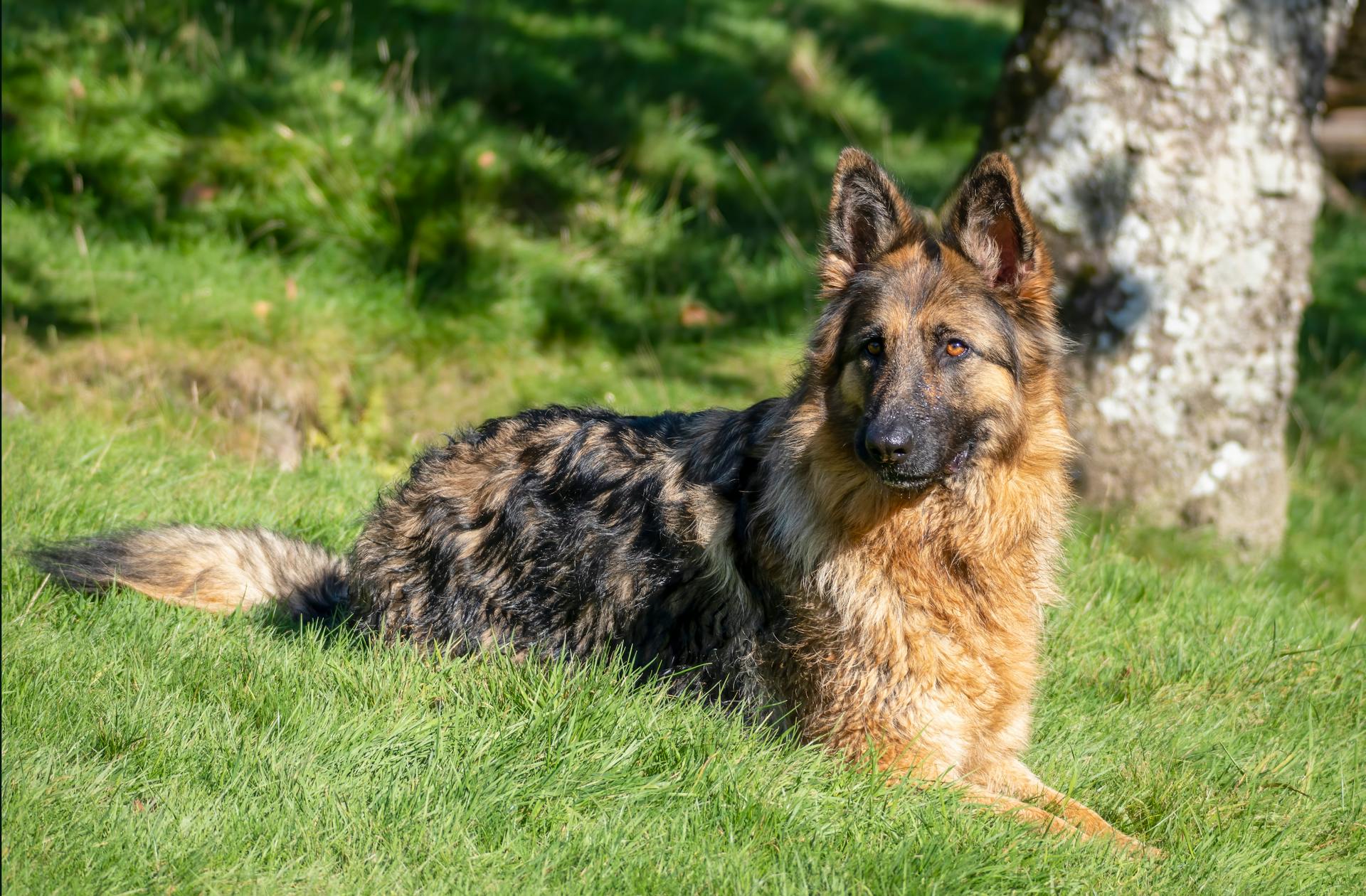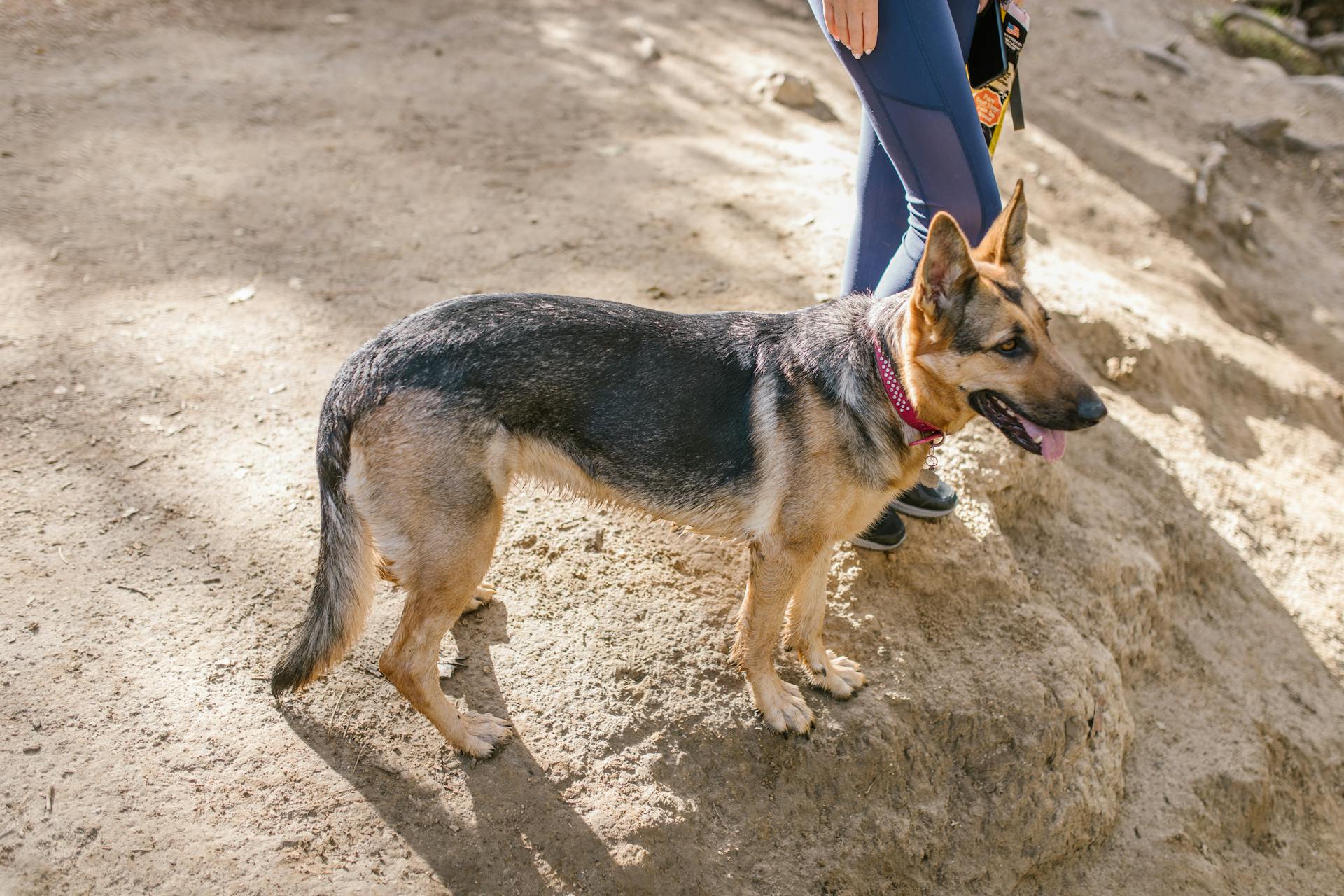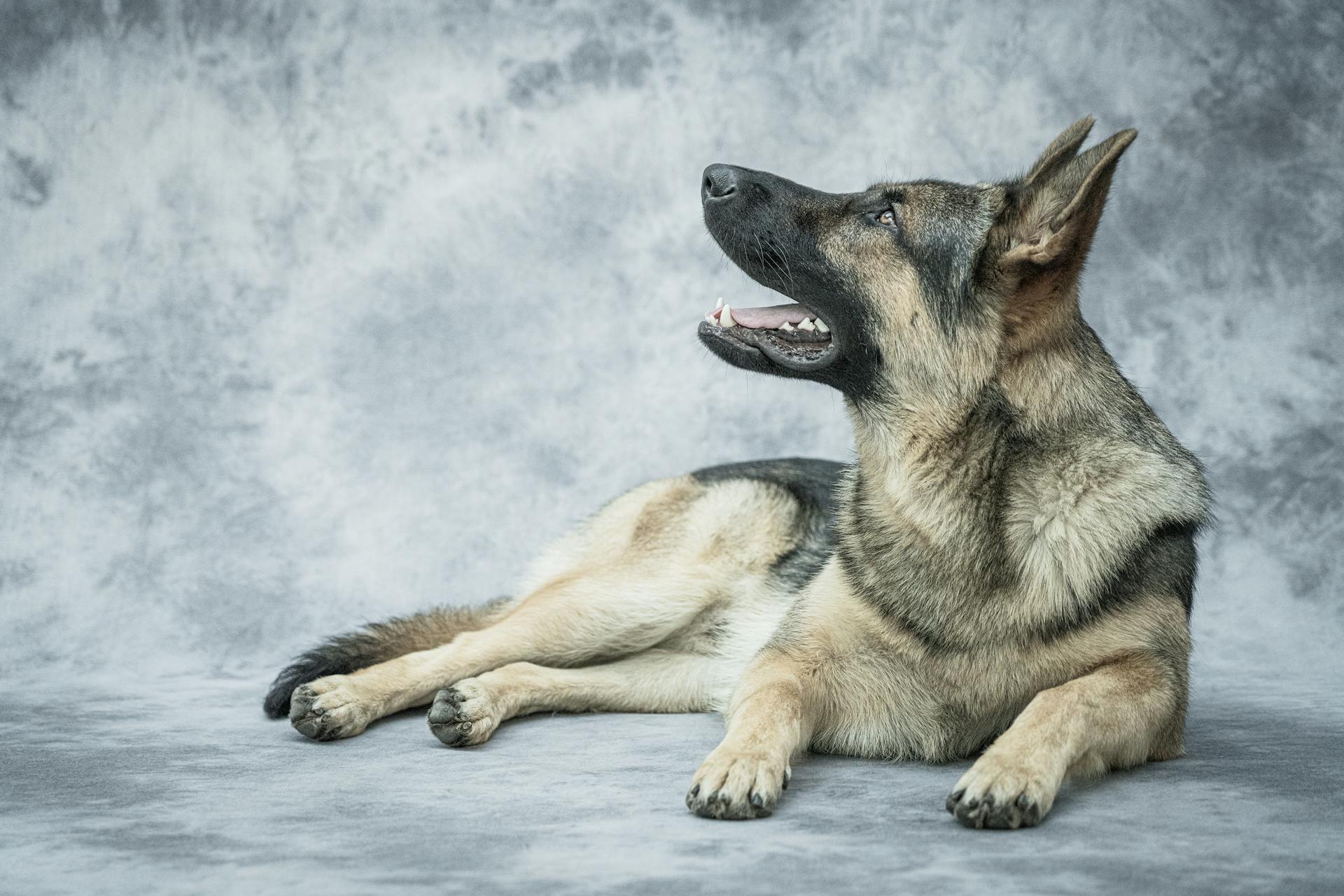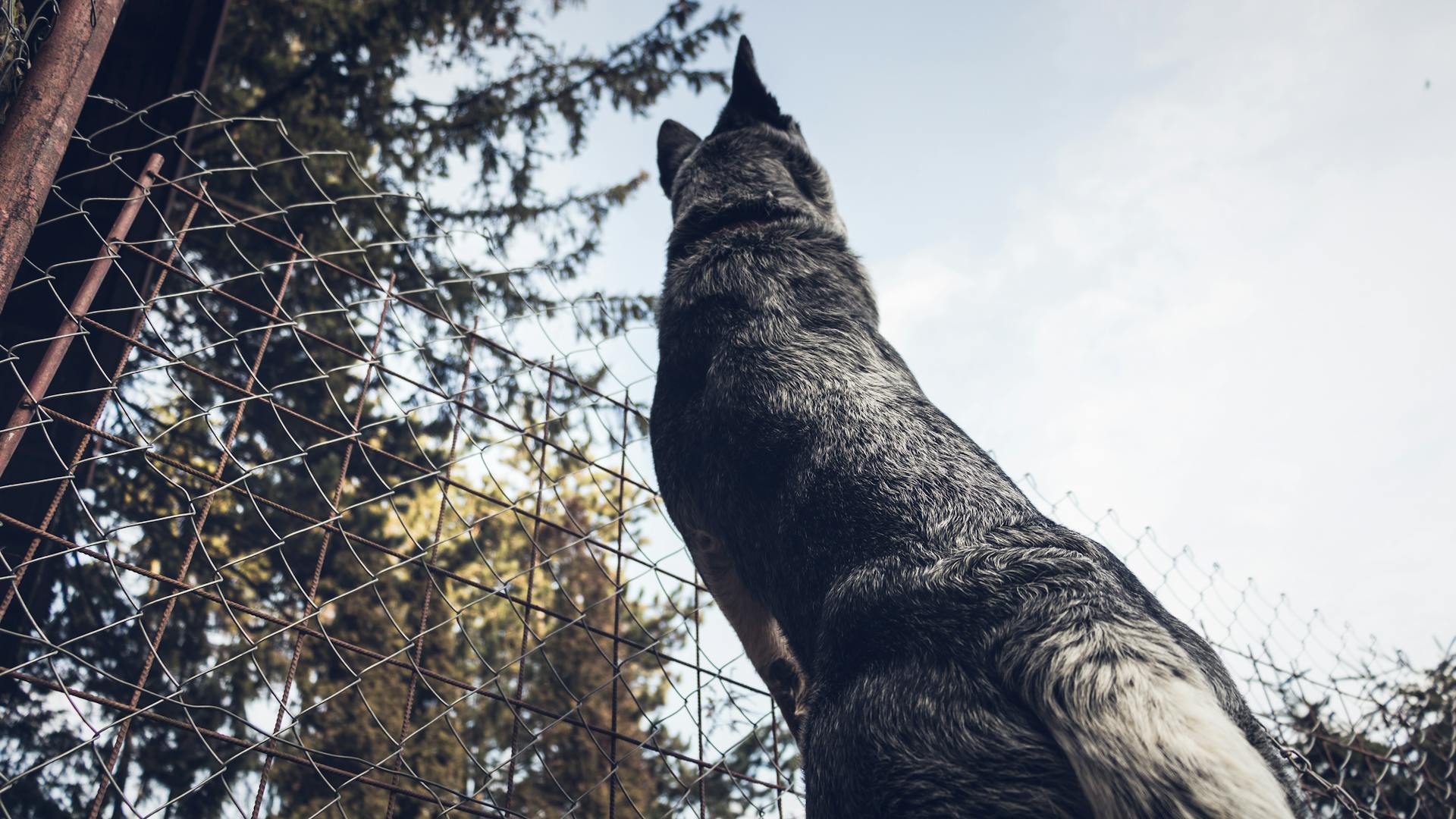
Long haired German Shepherds have been a topic of debate among dog enthusiasts, with some questioning their purity of breed. This debate stems from the fact that long hair is a recessive trait, which means it's not always immediately apparent in a dog's ancestry.
The long haired German Shepherd is a recognized variant of the breed, but its origins are rooted in the traditional German Shepherd's genetic makeup. This means that long haired German Shepherds are not a separate breed, but rather a variation of the existing breed.
The FCI (Fédération Cynologique Internationale) recognizes the long haired German Shepherd as a distinct type, but it's still considered a part of the German Shepherd breed. This recognition has helped to establish the long haired German Shepherd's legitimacy as a purebred dog.
See what others are reading: Long Haired Dogs Breeds
What is a Long-Haired German Shepherd?
The Long-Haired German Shepherd is a unique breed that's often misunderstood. They're considered a genetic defect, but this isn't entirely accurate. The health and lifespan of Long-Haired German Shepherds are no different than that of their Short-Haired counterparts.
Their coat is the most obvious difference, with a softer, silkier texture and a length of two or more inches. The Long-Haired German Shepherd's coat is single-layered, which means they shed pretty much the same amount as Short-Haired German Shepherds, but the shed hair gets caught in their fur.
They still need regular grooming, brushing them two to three times a week to prevent matting and tangling. This is especially important for Long-Haired German Shepherds without an undercoat, as their fur can quickly become matted and tangled.
Long-Haired German Shepherds are just as energetic as their Short-Haired counterparts, but exercising them in cold or wet weather can be challenging. They don't do well in freezing temperatures or rain, which may be a consideration if you live in a wet or cold climate.
Despite their differences, Long-Haired German Shepherds are still considered a purebred German Shepherd. However, they can't be registered with the AKC, which may affect their price. You can expect to pay between $500 and $1,000 for a Long-Haired German Shepherd without an undercoat.
The Long-Haired German Shepherd's temperament is also unique, with a more eager-to-please personality and a friendlier demeanor towards strangers. However, they were bred for their gorgeous coat, not their working capabilities, which makes them less suitable for working life.
A fresh viewpoint: Do German Shepherds Have an Undercoat
Identifying and Raising a Long-Haired German Shepherd
Identifying a long-haired German Shepherd puppy can be a bit tricky, but one way to do it is to look for wispier hair on the chest, back, face, tail, and the backside of its legs.
The photos from Nadelhaus litters show a clear distinction between long-haired and short-haired puppies, with the long-haired ones having that characteristic wispy coat.
If you're raising a long-haired German Shepherd, be aware that their coat requires regular grooming to prevent matting and tangling, especially around the face, ears, and legs.
How to Identify a Puppy
To identify a long-haired German Shepherd puppy, look for wispier hair on the chest, back, face, tail, and on the backside of its legs.
You can also compare the puppy to its litter mate, as photos of two litter mates from Nadelhaus litters show a clear difference between the long-coated and normal-coated puppies.
The key difference is the length and texture of the puppy's coat, with the long-coated puppy having a longer, wispier coat than the normal-coated puppy.
Long-haired German Shepherd puppies will have a more extensive coat that requires regular grooming to prevent matting and tangling.
By paying attention to these characteristics, you can confidently identify a long-haired German Shepherd puppy.
Readers also liked: How Long Are German Shepherds Puppies
How Rare Are They?
Long-haired German Shepherds are considered a less common variant of the breed, adding to their allure and exclusivity.
Genetically, the short hair gene is dominant and the long hair gene is recessive, which means two short-haired German Shepherds must carry the recessive long hair gene to produce long-haired puppies.
Finding a reputable breeder or rescue organization specializing in long-haired German Shepherds may require some research and patience due to their rarity.
Long-haired German Shepherds are a joy to own for those who appreciate their longer coats and exceptional qualities.
Readers also liked: Short Hair German Shepherds
Recurring Health Issues
Hip and Elbow Dysplasia is a common issue in Long-Haired German Shepherds, causing lameness and discomfort. This condition occurs when the hip or elbow joint pops out of its socket, leading to worn-down bones.
Epilepsy is another life-long chronic condition that affects this breed, causing seizures that can be managed with proper care. While it's a challenge, there's hope for comfort and quality of life.
On a similar theme: Do German Shepherds Have Hip Problems
Eczema, triggered by allergies, can cause skin irritation and inflammation in Long-Haired German Shepherds. Working with your vet to develop a treatment plan can help alleviate symptoms.
Digestive problems are a sensitive issue for this breed, with even small irregularities causing upset stomachs and diarrhea. A balanced diet, such as a mullet food option, can help alleviate these issues.
Some of the most significant health issues in Long-Haired German Shepherds include:
- Hip and Elbow Dysplasia
- Epilepsy
- Eczema
- Digestive problems
By being aware of these potential health issues and taking proactive steps, you can help ensure your Long-Haired German Shepherd lives a long and healthy life, with a typical lifespan of 9 to 13 years.
Long Haired
Long Haired German Shepherds are a unique breed, and it's essential to understand their characteristics to raise them effectively.
The long hair gene is a recessive gene, which means both parent dogs must carry it in order to pass it on to a puppy. This is why you might not find many breeders who intentionally breed for long-haired German Shepherds.
Long-haired German Shepherds have a single-layered coat that reaches two or more inches in length, giving them a silky and smooth appearance. They shed pretty much the same amount as short-haired German Shepherds, but the longer fur gets caught in the coat, making it look like they shed more.
To keep their coat looking its best, you'll need to brush them two to three times a week. This will help prevent matting and tangling, which can be painful for your pup.
The biggest difference between long-haired and short-haired German Shepherds is their ability to withstand certain elements. Long-haired German Shepherds are not as well-suited for working outside or being in cold weather due to their lack of a double coat.
Here are some key characteristics of long-haired German Shepherds:
- Coat length: 2-4 inches
- Coat type: Single-layered, silky and smooth
- Shedding: Same amount as short-haired German Shepherds, but appears to be more due to longer fur
- Brushing needs: 2-3 times a week
- Weather suitability: Not well-suited for working outside or cold weather
Long-haired German Shepherds are generally more eager to please their owners and are more friendly towards strangers, but they still require regular exercise and mental stimulation to prevent boredom and destructive behavior.
Long-Haired German Shepherd Breed Information
The long-haired German Shepherd is a unique breed with a few distinct characteristics. They have a long, soft coat that reaches two or more inches in length, and sheds pretty consistently all year round.
Their coat is single-layered, meaning they don't have an undercoat like their short-haired counterparts. This can make them more prone to matting and tangling, so regular brushing is a must.
Brushing a long-haired German Shepherd is a bit more involved than brushing a short-haired one, as you'll need to brush them two to three times a week to prevent matting.
Despite their unique coat, long-haired German Shepherds are still considered a purebred German Shepherd. They're just a variation of the breed, with some differences in their physical appearance and temperament.
One of the biggest differences between long-haired and short-haired German Shepherds is their ability to withstand the elements. Long-haired German Shepherds are less suited to working outside or being in cold weather due to their coat.
Long-haired German Shepherds are also generally more friendly towards strangers and more eager to please their owners. This makes them a great choice for families or individuals who want a loyal companion.
The cost of a long-haired German Shepherd can be lower than that of a short-haired one, as they're not eligible for registration with the AKC. You can expect to pay between $500 and $1,000 for a long-haired German Shepherd without an undercoat.
Frequently Asked Questions
Can a purebred German Shepherd have long hair?
Yes, a purebred German Shepherd can have long hair, although it's less common than the short-haired variety. Long-haired German Shepherds have a thick undercoat that sheds heavily in warmer months.
How do I know if my German Shepherd is purebred?
To verify if your German Shepherd is purebred, check for a registration document that shows its lineage going back at least three generations. A pedigree document from a reputable kennel club, such as the AKC, can confirm your dog's purebred status.
What is the origin of the long-haired German Shepherd?
The long-haired German Shepherd originated from traditional German herding dogs bred by Max von Stephanitz in 1899. Its development was initially focused on herding sheep, but it has since been adapted for various roles.
Featured Images: pexels.com


